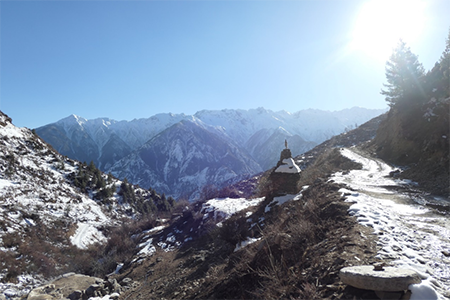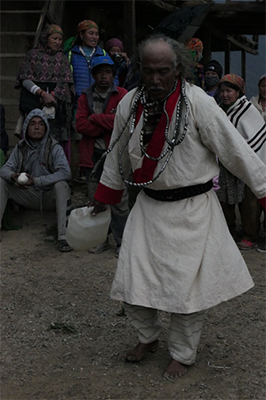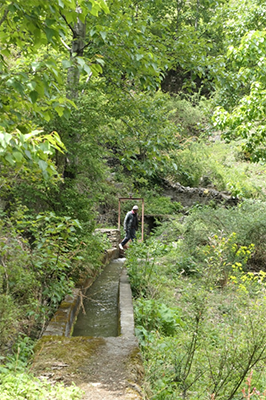Fieldwork
A social life of water
During my fieldwork, which took place in Tangshet, a village in northwest Nepal, I attempted to answer the deceptively simple question: who owns the water in Tangshet? Over a year of participation in the ritual, agricultural, political and social life of the village, and the wider Nyinba community of which it is a part, I began to de- and re-construct the categories at the heart of that question, asking: what do I mean by “Tangshet”? What do I mean by “water” in this place? And what would it mean to “own” that water, for me or for anyone else involved in village life?
Over the course of the year, it became clear that each of these words was being used to group multiple non-coterminous ideas. “Tangshet” was many things at once; “water” meant many things at once; and “ownership” was a constantly negotiated set of practices, in which ideas of use and responsibility predominated, and property rarely featured. A picture began to emerge from this of a world in which the various claims that people made on, and about, water reflexively structured many aspects of village social life.
Entering Tangshet
Separating Tangshet from the other four villages of the Nyinba community is the Chuta Lungba (the water-mill stream). This photograph shows the gully down which the stream runs, with the roof of one of the mills in the bottom left of the photograph, and a disused millstone (now a ngaltso, a resting place) by the side of the road.
Tangshet here is defined, as a space, by the stream – but the definition is not straightforward. The stream is at once a boundary between Tangshet and the other Nyinba villages, and the place where the villages meet – people come from all over Nyinba to use the mills. And the stream itself has many associations: indispensable, for the mills that it powers, it is also a source of danger, whose risks are managed with both old and new technologies – a new suspension footbridge (on the left of the photograph, further down the gully), and an old stupa built to duljia (tame) the spirit that lives by the stream.
Rain and Ritual
Water has many properties in Tangshet, but it is still viewed as a single, connected category, referred to as chu. Water powers mills, falls as snow or rain, waters fields, forms streams that separate villages, and is used to scald butchered goats, cool a blacksmith’s steel, and drive a small hydropower station – but it is all still chu.
Here, a spirit medium (daii) is performing a ritual dance at the spring ngoyang (the “festival of green”). This particular medium is associated with several of the village deities, but primarily with the yulsa, the deity of the village’s (yul) ground or earth (sa, sabi). When the yulsa possesses the daii at ngoyang, if there has been no rain, the yulsa will make the daii drink a huge quantity of water while possessed. This daii drank the majority of this 5l carton of water in a single effort. Half an hour later, the first spring rains started to fall. The ritual relied on the fundamental connection between the rain and the liquid in the taps – water may have many different associations, but it is all still chu.
Boxed In
Tangshet is also the site of a small hydropower station, fed by the same chuta lungba that forms the boundary at one end of the village. The station itself is slightly below the village, but all of the yura (drains, channels, tanks) that feed it are on village territory. This infrastructure is a source of both prosperity and disaster for the villagers. The hydropower yields (relatively) reliable electricity, and provides jobs. However, the scale of the infrastructure, coupled with its poor build quality, means that it causes frequent landslides and other issues.
The efforts made to control the water involve practices which in turn structure the movements of the people involved in them. Local government departments and villagers combine to build concrete channels within which the water must flow, metal sluice gates which regulate its volume, and tanks which store its excesses. In turn, the villagers find their movements structured by the infrastructure they have built, “boxed in” themselves by the effort to manage the water that they might claim to “own”.



